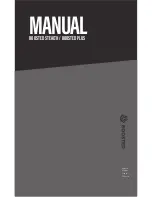
UM-0085-B09
DT80 Range User Manual
Page 308
RG
4–20mA Current Loops
Many different sensor types provide a 4-20mA current output, where the current is proportional to the quantity being
measured.
The channel type for a 4-20mA current loop measurement is
L
; channel options are as for Current measurements; see
.
To read a current loop sensor, the DT80 first measures the current. Any of the Current wiring configurations may be
used. The measured current is then scaled so that the channel returns 0% for 4mA and 100% for 20mA.
For example, if a current loop sensor is connected as per
C3 – Independent Current Input using Internal Shunt (P307)
then it would be read using
1#L
.
A span is often applied to this value so that the final reported value is in the proper engineering units for the quantity
being measured.
For example, if a pressure sensor with 4-20mA output operates over a range of 100-500kPa then
BEGIN S1=100,500"kPa" RA2S 4#L(S1) END
will return a pressure reading in kPa every 2s. The loop would in this case be connected across the
4#
and
AGND/EXT#
terminals, making use of the internal shunt resistor.
One advantage of a current loop system is that a cable fault can be readily detected. An open circuit loop will give a
negative reading, normally -25% (0mA), which can then be detected in an
ALARM
statement.
Multiple Devices in One Loop
Multiple measurement devices can be connected in series in the one current loop. For example, a current loop might
include both a DT80 and a 4-20mA digital panel display module, in series. (There can only be one 4-20mA sensor in a
given loop.)
In these situations care needs to be taken to ensure that the DT80's common mode voltage limits are not exceeded,
especially if the DT80 is placed "above" the other devices in the loop. The DT80's input attenuators may be enabled
using the
A
channel option, which will increase the common mode limit to ±35V, relative to
AGND/EXT#
Note:
If there are multiple devices in the loop then the loop should be continuously powered. This implies the use of an external shunt
(
C1 – Shared Terminal Current Inputs using External Shunts (P306),
as the DT80 normally disconnects the
EXT#
terminal between
measurements.
Resistance
Resistance (degree of impediment to current flow) is measured by passing a known
excitation current
through the
resistance and measuring the voltage across it. From Ohm's law, Resistance = Voltage / Current.
The
R
channel type returns the resistance value in ohms (Ω).
The DT80 Series 2, 3 incorporates two and Series 4 has a three precision current sources. When measuring a
resistance, one or other of these sources is switched through to the * (Excite) terminal, which is then connected to the
unknown resistance. (On Series 3 models, excitation can also be directed to the + or – terminals.)
By default, an accurately known current of approximately 200μA is generated by the DT80. This allows measurement of
resistances up to about 10kΩ. For low resistances (up to 700Ω), the
II
channel option can be used to select a higher
excitation current (2.5mA), which will allow a more accurate reading. In Series 4 an additional current source
III
with
current of approximately 2uA has been added to increase datataker capabilities to measure resistances up to 1MΩ.
One problem which occurs when measuring low resistance values is the fact that the wires used to connect the unknown
resistance to the logger also have resistance. As shown in the wiring diagrams below, there are various ways to
overcome this. These involve the use of separate wires to carry the excitation current and to sense the voltage.
For example, the channel
1R(4W)
will perform a
four-wire
measurement. Excitation current flows out the * terminal,
through the unknown R, and returns to the # terminal. Two separate
sense
wires connect the + and – terminals to the
unknown R. Because the DT80 has a very high input impedance (>10MΩ), negligible current will flow in these sense
wires, resulting in a negligible voltage drop. The measured voltage will therefore be the voltage across the unknown R
only, and will not include any voltage drop in the current-carrying excitation cables.
The downside of a four-wire measurement is that you need, well, four wires. The three and two wire configurations
provide for reduced cable cost, at the expense of accuracy.
















































